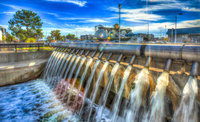Salt River Project has provided water and power to the Sonoran Desert for more than 100 years and is continuing to lay the foundation for a bright future despite formidable hurdles from the recession and increasing demands to reduce carbon emissions. The utility has helped shape the growth of Phoenix, and quite literally shaped the landscape in which the people of central Arizona live. Because of these reasons, plus SRP’s commitment to safety and community service, ENR Southwest has selected the utility as its 2011 Owner of the Year.

As the third-largest public power utility in the country, Tempe, Ariz.-based SRP serves nearly a million customers in the Phoenix area. In addition, SRP’s private subdivision, the Salt River Valley Water Users’ Association, delivers nearly 1 million acre ft of water annually to its service area in central Arizona.
SRP’s list of significant construction projects is lengthy. The $500-million Coolidge Generating Plant, the largest start on last year’s Top Starts ranking, is being developed by Calgary-based TransCanada for SRP and is due for completion in May. The simple-cycle, natural gas-fired peaking power generation station features 12 natural gas-fired turbines capable of producing an electrical output of approximately 575 MW.
SRP is developing its own $80-million Coronado Emissions Control Project, which appears at number nine on this year’s Top Starts. “One of the reasons that we self-build is that we have a lot of flexibility in terms of when we start off those projects,” says John Coggins, SRP’s resource planning manager.
This flexibility has allowed SRP to delay its new 800-MW, natural gas-fired plant near its Abel Substation in Florence, Ariz. “We’ve moved back the start date and are looking at phasing in the construction over a multi-year period beginning in 2016,” Coggins says.
One of the effects of the recession has been a valley-wide reduction in power consumption. “For the first time we’ve seen customer load growth come in at less than 1% a year,” says Debbie Kimberly, SRP’s energy efficiency and policy analysis manager. “Our [researchers] can’t recall a time we’ve ever seen that.”
Due to the infrastructure-intensive nature of utilities, delaying projects wasn’t enough to cover fixed costs irrespective of load. SRP’s management team recommended an 8% price increase—later reduced to 4.9% after aggressive cost-cutting, Kimberly says.
Since SRP builds, occupies and maintains its own facilities, many are designed to last more than 50 years. “Such a long service life drives the unique and stringent details and product requirements found in the drawings and specifications,” says Patti Pyle, senior procurement contract analyst. Since these specs often exceed city building codes, SRP ensures its contractors are performing quality work through a comprehensive quality assurance program.
Inspections are performed by SRP during and after execution of the work to guard against deficiencies and to ensure that construction complies with all requirements. In addition, commissioning and alternative delivery methods have been implemented on several of SRP’s recent projects, which Pyle says has helped enhance quality further.
“SRP is very involved in the construction process, more so than any other owner we have ever worked with,” says Greg Ayres, area manager of the industrial division for Tempe, Ariz.-based Sundt Construction, the general contractor on the Coronado project. “It is refreshing to see an owner who is willing to get their hands dirty and work side by side with the builder to create a great product.”
As SRP’s manager of major projects, Bill Rihs directs upward of 50 project managers in the field who oversee quality control and ensure project schedules are met. “Most contractors and engineers have a hard time getting used to us because today most owners go for a turnkey approach, with maybe one coordinator who keeps an eye on things but really doesn’t know what’s happening day to day,” Rihs says. SRP, on the other hand, sets all the parameters for schedules and milestones, and monitors projects on a daily basis. In some cases SRP will bid out each piece of work for a large plant and manage each contract. An in-house engineering staff oversees drawings and specifications.
“We demand a lot of our suppliers, and they become an extension of us,” says Art Oros, procurement services manager. “The best thing we can do—and I think the reason they like us—is that we pay them on time.”
Safety is another no-compromise aspect of all SRP work. “Firms attempting to do business with SRP must be able to demonstrate a commitment to safety, and we prescreen them through our contractor safety management program prior to qualifying as a prospective contractor,” Oros says. To home in on their safety performance, SRP scores each firm using OSHA reporting, experience modification ratios and other metrics.
Rihs says SRP has a strong safety record, citing an OSHA recordable rate of 1.28 on the Coronado project compared with the industry average of 4.3, and a lost time rate of 0.43 compared with 1.60.
“Every SRP meeting, whether it was in the office or out in the field, would start with a safety minute,” says Derek Kirkland, project executive with DPR Construction, Phoenix, general contractor on the Pinal County Call Center in Queen Creek, Ariz., one of SRP’s first construction-manager at-risk projects.
As with many utilities, SRP has had to find multiple strategies to reduce carbon emissions. In 2006, SRP’s publicly elected board of directors set sustainable portfolio requirements that demand that 15% of retail power commitments be met by sustainable resources by 2025. The company is ahead of plan: Currently 7.5% of commitments are met with conventional renewable resources and energy efficiency, Kimberly says.
As a public utility, SRP has to balance its sustainability goals with its mission to provide the lowest cost power and water to customers. “It just so happens that right now wind is one of the lowest cost utility-scale resources, and just within the last year we’ve doubled our commitment to wind energy,” Kimberly says. Earlier this year, Portland, Ore.-based Iberdrola Renewables completed phase two of the Dry Lake Wind Farm in northern Arizona. SRP will purchase 100% of the output of both phases—127 MW—for the next 20 years.
SRP is also delving into geothermal power. The utility will purchase 100% of the output from the $350-million, 50-MW Hudson Ranch I Geothermal Plant, scheduled for operation in the first quarter of 2012. It is being developed near the Salton Sea in California’s Imperial Valley by San Diego-based EnergySource.
Geothermal is an attractive power source because it is base-loaded, rather than intermittent like solar or wind power. “It looks like there will be enough resource for at least one other 50-MW unit,” Coggins says. SRP has the rights to additional development on the site as part of a 30-year purchase power agreement. “If that was built, we’d be looking to purchase the entire output of that project as well,” he adds.
“It is refreshing to see an owner who is willing to get their hands dirty and work side by side with the builder to create a great product.”
—Greg Ayres, Sundt Construction
SRP differs from investor-owned utilities in that it’s not regulated by the Arizona Corporation Commission. ACC requires that other utilities meet 30% of their renewable standard by using roof-top solar. “That’s an expensive proposition because what you are doing is collecting from all customers,” Kimberly says. Instead, SRP is investing in community solar plants like Copper Crossing, a 20-MW solar photovoltaic plant at the same site as the planned gas-fired plant near Florence. The power from this partnership with Iberdrola Renewables will be available for purchase to school districts or residential customers later this year.
SRP is heavily involved with K-12 education in other ways. SRP provides instructional support materials and mini-grants to enable teachers to buy supplies. “The model we use is train the trainer,” says Karen Fisch, SRP’s community outreach manager. “We’ve determined that we are better off doing professional development for teachers.”
Paul McElligott, a teacher with Fountain Hills High School, says that SRP’s grants helped him with project-based lessons—building a solar charging station and designing and constructing a fuel cell car—that allowed “students to apply math and science content knowledge to a real-world context.”
SRP also supports a wide range of community organizations, donating $3 million in 2010 alone. Fisch says 85% of employees volunteer time or contribute money, and all of the company’s executives serve on nonprofit boards. “It’s very much lead by example,” she says, “and that translates down into our organization.”




